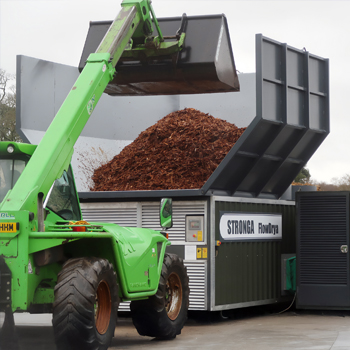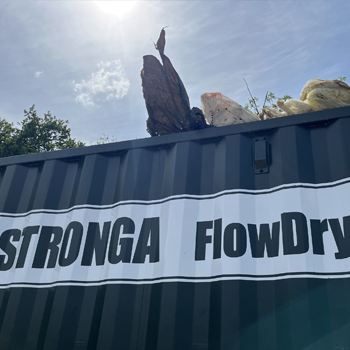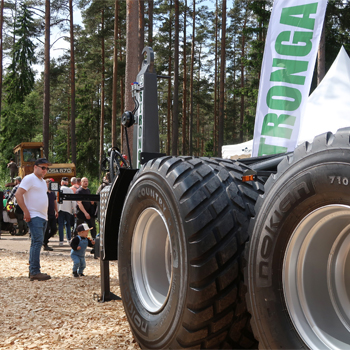Sphagnum Moss Enables Peatland Restoration
In the UK alone, peatlands store an estimated 3.2 billion tonnes of carbon; however, a massive amount of this is released back into the atmosphere each year through peatland degradation. The severity of peatland damage potential for the climate is highlighted by recently applied peat extraction and usage bans.
As a wider understanding of the qualities of Sphagnum moss become clear, it has become viewed as a restorative solution that possesses intrinsic qualities for both peatland restoration and peat-free growing potential. It is seen by pioneering agricultural companies as a leading solution to restore peatlands, reduce flood risks and sequester vast amounts of carbon. Learn below about Stronga’s work with UK-based peatland transformation and restoration company, BeadaMoss.

A Game-Changer in Reducing Emissions
Sphagnum moss is a fully renewable, non-vascular resource with over 300 different species worldwide, 30 of which are found in the UK. Identified as a “keystone species”, Sphagnum moss has been recognised as a game-changer in reducing global carbon emissions and restoring peatlands, locking away huge stores of carbon and thus, proving transformative in the growing industry.
Spongy Sphagnum bog mosses can act as natural flood mitigators by carpeting over wet peatlands, absorbing 20x its weight in water, preventing the decay of organic matter, only releasing water when required. Although Sphagnum moss is a non-rotting plant, due to the phenolic compounds present in the cell walls, it does eventually decompose to form peat.

“The Most Important Plant in the World”
The benefits of Sphagnum moss, nature’s best-kept secret, are extensive. Discover just a few below:
Restores barren land and peatland marshes through moisture retention and carbon sequestration ✓
Reduces greenhouse gas (GHG) emissions from degraded peatlands ✓
Sphagnum moss can be used as a highly-useful, organic growing media constituent ✓
Sphagnum moss can be used as a natural mulch, weed suppressant ✓
Compatible for use with various substrates (bark/coir/composts/soil improvers) ✓
Improves soil structure by increasing water retention (up to 20X its weight) ✓
Offers excellent aeration capabilities (to lighten clay and heavy, compacted soils) ✓
Makes for an excellent seed starter for the growth of juvenile plants ✓
Provides good airflow, promoting healthy plant/crop roots ✓
This graph below, adapted from the BeadaMoss website, illustrates the vast difference in tonnes of carbon per hectare of intact and extracted peatland sites.

BeadaMoss’ Sphagnum Initiative
Taking the crucial initiative to reverse centuries of peatland damage, the team at BeadaMoss have taken the decision to utilise Sphagnum - a ‘super-moss’ with valuable preservation and enhancement qualities, and also the potential to create a valuable income stream for their business.
BeadaMoss are a family-owned nursery based in Loughborough in the UK. As innovators in Sphagnum technology, they are pioneering for the best peat-free alternatives using peatland restoration projects and carbon-reduction farming methods. Growing micro-propagated Sphagnum, harvested from native sites, enables BeadaMoss to restore peatland at a much faster rate, using their ‘BeadaHumok’ trademark product.
The photo below shows Sadie from BeadaMoss, holding their Sphagnum cube which featured at the COP26 Peatland Pavilion. While growing, the Sphagnum in the small cube Sadie is holding has captured 240 litres of atmospheric carbon dioxide. This is just one small example of the pioneering work going on at BeadaMoss.

BeadaMoss: Future-Proofing with FlowSteama
Over the years, BeadaMoss have invested decades of research into their pioneering micro-propagation (plant tissue culture) strategy, aiming to grow and harvest the super-species in the most efficient way possible, and to have the best possible influence on the environment.
Recognising the potential in steam heat-treating compost blends from previous crop cycles as a suitably-sterilised “yield-booster”, BeadaMoss took the decision to approach Stronga. They view FlowSteama as an “enabling” technology for the continuous growing of Sphagnum and, as hygiene remains central to their process, see steam heat treatment as laying the foundation for successful and healthy growing, moving forwards.

Steam Sterilising Bark Blends
In the competitive growing industry, it is essential to utilise growing substrates that deliver high yields and healthy crops. BeadaMoss use a specific bark blend to grow Sphagnum moss. A key issue they face, though, is that supply issues of the bark mix have the potential to negatively impact production capacity. FlowSteama’s steam sterilisation process has the potential to add security to their operation, enabling on-site control over material pasteurisation to allow reuse of the same blend, multiple times over.
Overall, FlowSteama provides:
1) The elimination of specific problem pests associated with damp conditions which have the potential to cause population explosions.
2) Pest and pathogen prevention, essential for production of BeadaMoss’ peat-free Sphagnum growing blends.
3) Resource recycling of specific bark and sphagnum blends, fulfilling demand while reducing costs and delays associated with importing coir.
4) Evidenced steam sterilisation, assuring growers that the output is free of harmful pathogens and pests.

What Can FlowSteama Offer You?
A key benefit of the FlowSteama is the ability to steam materials in continuous or batch modes, heat-treating growing blends with energy-efficient, super-heated steam. With the potential for materials to reach temperatures of 85’C+, FlowSteama comfortably reaches the steam sterilisation requirements outlined by experts - Kenneth Baker and W.J.C Lawrence - and is therefore highly effective in destroying the vast majority of detrimental organisms.
Steam sterilisation ensures a clean growing environment for prosperous crop and plant development. Without leaving behind chemical residues, it increases the market appeal of grown produce by eradicating invasive species, safely. It is transformative for businesses like BeadaMoss, facilitating the enhanced growth of Sphagnum moss hummocks while increasing production, sales and distribution of Sphagnum on peatland areas.

Discover the Benefits of FlowSteama
- FlowSteama’s PulseWave™ agitation system ensures thorough sterilisation of the entire load.
- With batch and continuous mode options, FlowSteama offers a super-low labour requirement.
- FlowSteama is fully insulated, ensuring minimal heat energy is lost during the pasteurisation process.
- Optional energy recuperation systems enable clients to save up to 30% of the fuel consumed.
- FlowSteama delivers in-house control over growing blends while reducing losses caused by infected imported substrates.
- Easy to operate, SteamStation™ HMI controls allow operators to easily adjust time at temperature while temperature probes provide assurance of adequate steam treatment.
- FlowSteama directly increases Sphagnum moss yields through increasing the availability of growing blends, scaling-up projects and increasing asset distribution opportunities.
The team at Stronga scale each FlowSteama to the customer’s individual requirements; leading them through the process with care and consideration. For BeadaMoss, we were able to recommend a solution that would deliver on their goals of increased growing media availability in the most energy-efficient approach, possible.

Sphagnum Moss; An Extremely Valuable Asset
BeadaMoss are rightly concerned with the integrity of their business as they look to expand their operation moving forwards. By cooperating with Stronga, their hard-working team would be able to steam sterilise growing blends before micro-propagation, ensuring minimal risk of infection whilst taking full control over on-site recycling.
At Stronga, we like finding situations where our products add value for our customers, and for the environment. If you recognise the value in recycling spent growing media and finding enhanced peat-free alternatives, collaborate with Stronga today - info@stronga.co.uk
Note - Projects that actively restore peatlands are often eligible for significant grant funding; speak to your local authority for more information.



Share this post